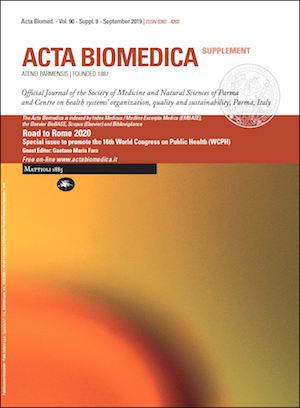On field vaccine effectiveness in three periods of 2018/2019 influenza season in Emilia-Romagna Region
Keywords:
influenza, influenza-like illness, virological surveillance, vaccine effectiveness, test-negative case-control designAbstract
Background and aim of the work: Epidemic influenza is associated with significant morbidity and mortality, particularly in people at risk. The vaccine reduces complications, hospitalization and mortality excess, as well as health care and social costs. Aim of the study was to estimate the influenza vaccine effectiveness (VE) in Emilia-Romagna Region during the 2018/2019 season. Methods: Within the context of virological surveillance conducted at the Regional Reference Laboratory of Parma, nasal/throat swabs were performed by sentinel practitioners and clinicians, on patients with ILI (Influenza-like illness). VE estimates, overall and against subtype A(H1N1)pdm09 and A(H3N2), were evaluated in three periods of the season, using a test-negative case-control design. Results: From November 2018 to April 2019, 2,230 specimens were analyzed: 1,674 (75.1%) performed by clinicians and 556 (24.9%) by sentinel practitioners of the regional network. The season was characterized by the predominant circulation of influenza type A viruses: 57.4% belonged to subtype A(H3N2), 41.2% to subtype A(H1N1)pdm09. 23.5% of patients was vaccinated against influenza with quadrivalent or adjuvate vaccine. The overall VE was -5% (95% CI -33% - 18%) with a decreasing trend during the season. The overall VE against subtype A(H1N1)pdm09 was 39% (95% CI 11% - 58%) and remained stable during the season. The overall VE against subtype A(H3N2) was -43% (95% CI -89% - -9%), and showed an important decreasing trend. Conclusions: The possibility to make accurate and continuous VE estimates during the season will help to better define the composition of the vaccine for the following season.
Downloads
Published
Issue
Section
License
This is an Open Access article distributed under the terms of the Creative Commons Attribution License (https://creativecommons.org/licenses/by-nc/4.0) which permits unrestricted use, distribution, and reproduction in any medium, provided the original work is properly cited.
Transfer of Copyright and Permission to Reproduce Parts of Published Papers.
Authors retain the copyright for their published work. No formal permission will be required to reproduce parts (tables or illustrations) of published papers, provided the source is quoted appropriately and reproduction has no commercial intent. Reproductions with commercial intent will require written permission and payment of royalties.







